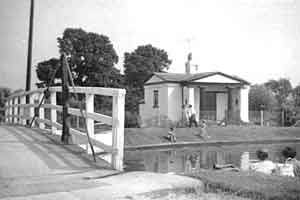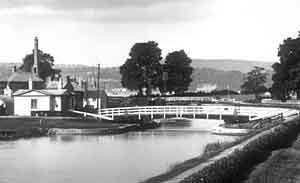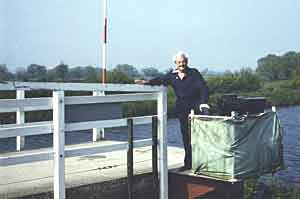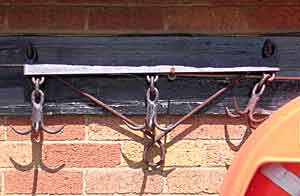Bridgemen
Each
of the road bridges along the canal was looked after by a specific
bridgeman, with one man covering the two bridges close together
at Purton. Each man was expected to open his bridge for any vessel
passing along the canal, although sometimes this was done by a member
of his family, and he could be called out at night for a small extra
payment. The bridgemen were the public face of the Canal Company,
being well known not only to regular users of the canal but also
to local people who needed to cross the bridges.
 Bridge
Houses Bridge
Houses
The early bridgemen lived in existing houses and
were just provided with a simple brick hut for shelter while on
duty. Later, to allow the canal to be used at night, it was important
to have each bridgeman living close to his bridge, and distinctive
classical-style houses were built at some bridges, where required,
in the 1840s and 1850s. These originally had a basic plan in the
shape of a Greek cross, providing two rooms and a scullery with
a portico at the front having a pediment supported by two Doric
columns. They have later been given additional rooms, either by
an extension on the level or by using the original basement which
was built into the canal bank. As things turned out, only eight
of these classical-style bridge houses were constructed, and later
houses were built according to the needs and fashions of their times.
Some bridge houses were provided with a well in the garden, but
at others the inhabitants were expected to drink water from the
canal that was passed though a simple gravel filter. (Picture of
Splatt bridge house: R&CHS)
|
 Early
Wooden Bridges Early
Wooden Bridges
Each road bridge originally comprised two
wooden half-spans which could be swung open to let vessels pass
through. The bridgeman opened one side of the bridge, and someone
accompanying the vessel along the towpath opened the other side.
Each half-span was rotated by pushing on a long arm attached to
the tail of the span. For the bridges near to Gloucester which were
mounted on small diameter piers, a curved wooden staging was provided
for the bridgeman to walk out on while doing this. The bridges from
Hardwicke southwards were mounted on larger piers and so there was
no need for staging. (Picture of Purton Bridges: Glos Archives)
|
 Post-war
Steel Bridges Post-war
Steel Bridges
In the 1950s and 1960s, the original wooden
bridges were replaced by single-span steel bridges that could be
opened by one man turning a handle. This did away with the need
for someone to accompany vessels along the towpath. It was important
to keep the gearing well greased, but even so it could be difficult
to start swinging the bridge, particularly if there was any adverse
wind. Light signals were installed so that the bridgeman could define
priority, and red & white poles were fitted to help helmsmen
see the bridge opening clearly. In recent years, some of the bridges
have been mechanised and two can be operated remotely. (Picture
of Vernon Hemming at Cambridge Arms Bridge: Martin Hemming)
|
 Other
Duties Other
Duties
In his spare time, a bridgeman had to keep his bridge
clean and in good working order and look after about fifty yards
of bank on either side of the bridge. On one specified day of the
year, he had to close the towpath to the public to prevent it becoming
established as a public right of way. An occasional distressing
duty was to help recover a body from the canal using the drags provided
by the Canal Company (picture right). In the twentieth century,
some of the bridgemen were responsible for collecting rent for holiday
bungalows built on the canal bank near their bridge.
|